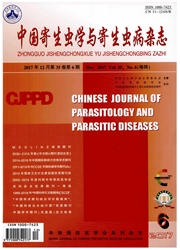

 中文摘要:
中文摘要:
目的 分析云南省恶性疟原虫抗氯喹转运蛋白(Plasmodium falciparum chloroquine resistant transporter, Pfcrt)基因和青蒿素抗性相关(K13)基因的联合突变特性。 方法 收集2012年8月-2015年12月寄生虫病防治信息管理系统登记和报告的云南省恶性疟病例滤纸血样和流行病学史等相关信息,提取疟原虫DNA,巢式PCR扩增恶性疟原虫Pfcrt基因exon2区和K13基因kelch结构域并测序,测序序列与2655199、PF3D7_1343700参比序列进行比对,用MEGA 5.04、Arlequin 3.01软件分析Pfcrt基因exon2区、K13基因kelch结构域的单倍型、单倍型间期望杂合度(He)及其群体间的遗传分化指数(Fst)等,用Network 4.6.0软件制作单倍型中介网络进化图,采用Epi Data 3.1软件建立数据库,SPSS 21.0统计学软件进行数据分析。 结果 共收集恶性疟病例血样234份,Pfcrt基因exon2区、K13基因kelch结构域巢式PCR扩增产物同时成功测序192份。其中,云南省本地感染病例血样12份,自非洲、缅甸感染的病例血样分别为30和150份。218份血样的Pfcrt基因exon2区DNA序列有7种单倍型,He为0.238 5,错义突变序列占83.0%(181/218),72~76位点呈单重突变(CVMNT)、双重突变(SVMNT)、三重突变(CVIET)的比例分别为1.8%(4/218)、6.4%(14/218)和74.8%(163/218),7种单倍型以氯喹敏感型CVMNK为起始,再按单重、双重及三重突变的路径逐步进化。192份血样的K13基因kelch结构域DNA序列有21种单倍型,He为0.044 9,错义突变序列占35.9%(69/192),在16、446、676等9个位点均只发生单重突变,F446I的突变率最高,为25.0%(48/192),21种单倍型的中介网络图显示“星状”布局。云南省本地恶性疟原虫种群与缅甸种群间的Fst最小,为0.020 3。Pfcrt基因的氯喹敏感型CVMNK血样中,K13基因kelch结构域位点突变的比例为20.6%(7/34),氯喹抗性型CVMNT、CVIET血样中的检出比例分
 英文摘要:
英文摘要:
Objective To analyze the co-mutation property of chloroquine resistant transporter gene(Pfcrt) and artemisinin-resistant gene K13 in Plasmodium falciparum based on reported malaria cases in Yunnan Province, in order to help unveil the mechanisms of multidrug resistance of P. falciparum. Methods The dry blood samples on filter paper were collected from falciparum malaria patients reported through the Reporting System of Chinese Center for Disease Control and Prevention from August 2012 to December 2016. The corresponding epidemiological data were collected as well. DNA was extracted from P. falciparum, and the exon2 region in Pfcrt gene and K13 kelch domain were amplified with nest-PCR. PCR products were sequenced, and the sequences were aligned with the reference sequences 2655199 and PF3D7_1343700. The haplotype number, expected heterozygosity(He), and genetic differentiation(fixation index, Fst) of the exon 2 region of Pfcrt and K13 kelch domain were analyzed by MEGA 5.04 and Arlequin 3.01 softwares. The haplotype media evolution tree was drawn with the Network 4.6.0 software. Data were analyzed with SPSS 21.0 software. Results A total of 234 blood samples were collected. The PCR results showed that the targets were amplified and 218 products of exon2 region of Pfcrt and 192 products of kelch domain of K13 were sequenced. Among them, 192 blood samples were simultaneously analyzed for the genotypes of Pfcrt and K13, including 12 samples of Yunnan local origin, 30 of Africa origin, and 150 of Myanmar origin. There were seven haplotypes for the exon2 region of Pfcrt in 218 samples, with an He of 0.238 5 and 83.0%(181/218) missense mutations. The proportions of single-locus mutation(CVMNT genotype), double-loci mutation (SVMNT genotype) and three-loci mutation(CVIET genotype) in the 72-76 nucleotide locus were 1.8%(4/218), 6.4%(14/218) and 74.8%(163/218), respectively. The media network diagram from the seven haplotypes showed that the haplotype first occurred as 72-76 locus
 同期刊论文项目
同期刊论文项目
 同项目期刊论文
同项目期刊论文
 期刊信息
期刊信息
